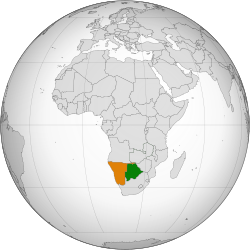Botswana–Namibia relations refers to the current and historical relationship between Botswana and Namibia. Botswana gained independence from Britain in September 1966. Namibia gained independence from South Africa in 1990 following the Namibian War of Independence, and the two countries soon after established formal diplomatic relations. Botswana has a high commission in Windhoek.[1] Namibia has a high commission in Gaborone.[2] Both countries are members of the Southern African Development Community, African Union, Group of 77, and Commonwealth of Nations.
 | |
Botswana |
Namibia |
|---|---|
Treaties
editAs of 2008, there was no treaty covering the long border between Botswana and Namibia.[3] The border remains as defined by a treaty signed on 1 July 1890 between Great Britain and Germany delimiting their respective spheres of influence in Africa.[4] Disputes about the border led in the 1990s to considerable tension between the two governments.[5]
In 1994, Botswana, Namibia and Angola agreed to establish the Okavango River Basin Commission, with a view to establishing a treaty governing joint use of the water resources, but progress towards finalizing the treaty has been slow.[6] In 2004, Botswana and Namibia were cosignatories along with other states of the Zambezi river basin of an agreement establishing the Zambezi Watercourse Commission to manage the riparian resources of the Zambezi.[7][8]
Economic cooperation
editIn 2002 the Namibia and Botswana Power Corporations signed an agreement to supply electricity to the Ghanzi and De Hoek areas in Botswana and Namibia respectively.[9] Namibia and Botswana have been considering collaboration on development of new fiber-optic communications to bypass South Africa, in an effort to reduce costs.[10] In 2008, South Africa, Botswana, Namibia and Zimbabwe held a legal joint sale behind closed doors in Namibia of seven tons of ivory, earning more than US$1.18 million, to Chinese and Japanese bidders.[11] In October 2008 Namibia approved the proposal by a private company to export coal from Botswana via a railway to be constructed to Namibian ports. The Mmamabula deposit is said to possess about 2.8 billion tonnes of coal reserves (see Mining industry of Botswana).
Disputes
editBotswana and Namibia had a long-running dispute about ownership of the Kasikili / Sedudu island in the Chobe River, which forms part of the border between the two countries.[12] In December 1999, Judges at the World Court ruled that the island belongs to Botswana.[13] In the Caprivi Strip, the UNHCR reported that between October 1998 and February 1999 more than 2,400 Namibians crossed south into Botswana.[14]
The Okavango Delta in Botswana is an area famous internationally for its birds and wildlife and an important source of tourist revenue, but depends on the Okavango River which flows from Angola via Namibia. In 1997 Namibia had been facing an extended drought and announced plans to divert water from the river, which threatened to become a serious issue between the two countries.[15]
Namibia has been critical of Botswana's "shoot to kill" policy against wildlife poachers. In 2015 and in 2020 several Namibians were killed as suspected poachers by the Botswana military.[16]
See also
editReferences
edit- ^ "Botswana High Commission Website in Namibia". Botswana Ministry of Foreign Affairs. Archived from the original on 2009-05-04. Retrieved 2009-07-14.
- ^ "Namibia Embassy in Botswana". Retrieved 2009-07-14.
- ^ Bame Piet. "Botswana has no border treaty with Zim, Namibia". Mmegi. Archived from the original on 2017-10-02. Retrieved 2009-07-15.
- ^ "Case concerning Kasikili/Sedudu Island". Max Planck Institute for Comparative Public Law and International Law. Archived from the original on 2012-02-19. Retrieved 2009-07-15.
- ^ Alex Vines (November 1996). "Of arms and islands: The Botswana Namibia cold war". Africa Files. Archived from the original on 2016-03-03. Retrieved 2009-07-15.
- ^ Paula Hardy; Matthew D. Firestone (2007). Botswana & Namibia. Lonely Planet. p. 72. ISBN 978-1-74104-760-8.
- ^ "AGREEMENT ON THE ESTABLISHMENT OF THE ZAMBEZI WATERCOURSE COMMISSION" (PDF). Zacpro: Zambezi River Action Plan. Retrieved 2009-07-15.[permanent dead link]
- ^ Olli Varis; Cecilia Tortajada; Asit K. Biswas (2008). Management of Transboundary Rivers and Lakes. Springer. p. 59ff. ISBN 3-540-74926-8.
- ^ "Namibia-Botswana Power Corporations Sign Agreement". Southern Africa Documentation and Cooperation Centre. Archived from the original on 2017-10-03. Retrieved 2009-07-14.
- ^ "Now Angola, Namibia, Botswana mull global fibre alternative". Creamer Media (Pty) Ltd. 31 August 2007. Retrieved 2009-07-14.
- ^ Berger, Sebastien (28 Oct 2008). "Elephant tusks sold legally for first time in a decade". London: Telegraph Media Group. Retrieved 2009-07-14.
- ^ "Namibia-Botswana border dispute before UN court". BBC News. February 15, 1999. Retrieved 2009-07-14.
- ^ LAUREN COMITEAU (1999-12-13). "WORLD COURT/NAMIBIA/BOTSWANA (L-O)". GlobalSecurity.org. Retrieved 2009-07-14.
- ^ "NAMIBIA-BOTSWANA: Border tensions 1999.2.15". UNIVERSITY OF PENNSYLVANIA – AFRICAN STUDIES CENTER. Retrieved 2009-07-14.
- ^ "Namibia / Botswana Water Wars". ABC. 1997-09-09. Archived from the original on 2008-02-03. Retrieved 2009-07-14.
- ^ Ngutjinazo, Okeri; Mbathera, Ester (11 November 2020). "Geingob engages Masisi on 'shoot to kill' policy". The Namibian. p. 1.
External links
edit- Peter Batchelor; Kees Kingma; Guy Lamb (2004). Demilitarisation and Peace-building in Southern Africa: National and regional experiences. Ashgate Publishing, Ltd. p. 237. ISBN 0-7546-3315-2.